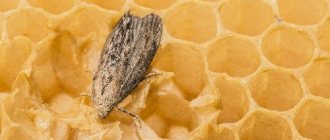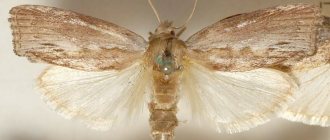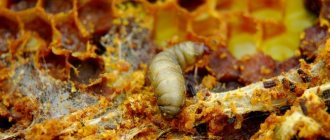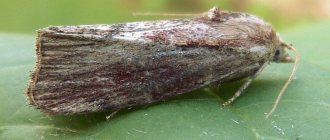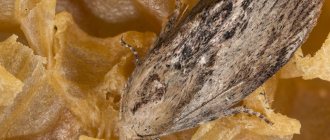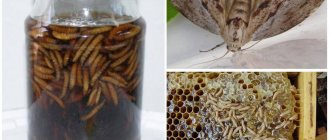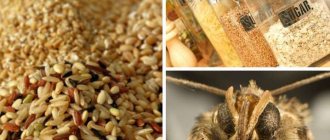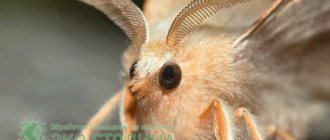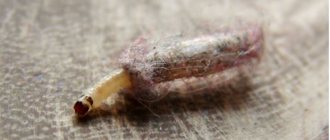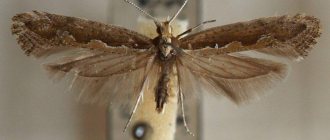Wax moth or bee moth is a pest that poses a threat to beekeepers. This insect lives and breeds in hives. The most dangerous are the larvae that destroy bee products. To prepare the medicine, insects are collected at the initial stage of development. They have a positive effect on the body due to a large number of beneficial substances. For this reason, larvae are used to treat various diseases.
Wax moth is a dangerous pest that parasitizes bee hives.
Features of the insect
Wax moths exude a honey smell, so they easily enter the hives. Bees do not see pests as a threat; they mistake them for their relatives. The insect is small in size and has a gray body color. Found in beekeeping farms. Pests also reproduce in hives: they leave offspring on the honeycombs. When the larvae emerge from the eggs, they begin to actively feed on honey and beebread.
As the moth offspring grow, they begin to destroy the wax frames. At the same time, the larvae eat the remains of the cocoons, receiving an additional dose of nutrients.
Pests also damage bee pupae. The larvae can also destroy the insulation of the hive. Silk remains in the passages after them.
Insects destroy each other's waste products and can eat their fellow insects if they feel a lack of food. This happens with severe infection. Subsequently, the larvae pupate in the hives.
Male and female lesser wax moth.
Adults do not feed on bee products because their mouthparts are not formed. They do not live long, and at the same time they consume useful substances accumulated during the developmental stage in the larval stage. The bee family gradually dies or leaves the hive.
Bee moth
Bee moth (wax moth) is one of the most malicious pests that penetrate the hive. To protect themselves, they even developed a special mechanism - a smell that imitates the smell of the family. And although the bees try to fight by throwing butterflies out of the hive and sealing or eating larvae, when darkness falls, this activity stops. Little workers at night are engaged in an important process - evaporating moisture from honey. After sitting motionless for a day, the hatched butterflies remaining in the hive begin to lay eggs.
The wax moth larva during its development (about 30 days) is capable of destroying up to 600 honeycombs. This amounts to about 2 g of wax by weight. And one generation of larvae can spoil up to 20 kg of honeycomb. Moreover, everything that gets in the way is destroyed - honey, bee bread, bee larvae.
Medicinal properties and chemical composition
Before using a medicine based on wax moth larvae, you need to learn about its benefits and harms. Despite the danger insects pose, they are used for medicinal purposes.
The healing properties of the larvae are due to the fact that the offspring of the moth consume bee products in large quantities.
Thanks to this, a significant supply of nutrients is deposited in their body.
Including the following components:
The effect of wax moth tincture on the human body.
- Cerraz. An enzymatic substance involved in the process of wax breakdown.
- Lipase. An enzyme that promotes the digestion of fats.
- Glycine. Improves memory, has a positive effect on nootropic processes.
- Valin. An amino acid found in proteins. The substance activates energy metabolism, increases the body's endurance under the influence of intense loads.
- Leucine. Another amino acid. With its participation, the process of protein destruction slows down, sugar levels and serotonin synthesis are normalized.
- Serin. Amino acid. Participates in the process of cellular energy production.
- Alanin. Strengthens muscle tissue, normalizes sugar levels.
- Lysine. An amino acid that promotes protein formation.
- Glutamic acid. A substance from the amino acid group that participates in nitrogen metabolism.
- Aspartic acid. With a deficiency of this component, there is a decrease in immunity, sleep and central nervous system disturbances, and headaches often occur.
Wax moth-based products contain micro- and macroelements: copper, manganese, molybdenum, magnesium, phosphorus, selenium, iron, chromium, cobalt, potassium, zinc.
The list of useful properties includes:
- antibacterial;
- anti-inflammatory;
- wound healing;
- antiviral;
- stimulating;
- cardioprotective;
- bronchodilator;
- immunostimulating;
- restorative;
- anti-tuberculosis;
- antiandrogenic;
- hypocholesterolemic.
Scientific aspects of the extract's effectiveness
And yet, how effective is the extracted bee moth preparation? If we abstract from the fictitious reviews and advertising brochures of the manufacturers of the product, then there is no data that would confirm the effective extract.
As noted above, beekeepers and manufacturers claim that the product contains the enzyme component cerrase, an unusual substance that has the ability to destroy the lipid membranes of bacterial cells.
However, experts are very skeptical about this opinion, citing a number of arguments.
- First of all, scientists are not familiar with such a substance as cerrase. A similar ingredient is described by the manufacturers of numerous dietary supplements and medicines made from moth larvae.
- Even if we assume that cerrase is not an invention of cunning manufacturers, then, judging by the declared properties, the enzyme should dissolve all bacterial cells, including beneficial lactobacilli contained in the digestive tract.
Particularly strict critics are completely convinced that the wonderful qualities of the extract were invented by enterprising beekeepers who, losing money due to moth larvae, decide to replenish their budget with such a unique beekeeping by-product.
However, some patients who have used a similar drug are still confident in its effectiveness and numerous beneficial qualities. What is this – a placebo effect or ingredients unknown to science? There is no exact answer to this question yet.
Directions for use and dosage
Alcohol tincture is used to treat various diseases. It is based only on wax moth. The dosage regimen is selected individually, since an excess of micro- and macroelements can lead to an overdose and the development of complications. For this reason, the doses of the substance differ significantly. In folk medicine, this remedy is used orally and externally.
Universal application
It is recommended to purchase the drug at 10% concentration. Instructions for use: single dose – no more than 20 drops. To accurately calculate the sufficient amount of medicine, you should take the following ratio as a basis: 3 drops per 10 kg of weight.
The product is diluted with water. If the tincture is more concentrated (20%), the above amount is divided by 2. As a result, the single dose will be less - up to 10 drops. This does not reduce the benefit to the body.
The frequency of administration differs. For example, to prevent colds, it is recommended to drink the tincture no more than once a day. For the purpose of therapy as part of complex treatment, the drug is taken 2 times a day.
Useful properties of wax moth larvae tincture.
External use
Due to its beneficial properties, the tincture is also effective when applied to the skin. It has a moderate analgesic, anti-inflammatory, antiseptic and wound healing effect. The product is used to eliminate symptoms of skin and joint diseases. In this case, ointment is also used.
The drug is used if there is no allergy. They check the body’s tendency to develop negative reactions by applying a small amount of the substance to an area of the skin that is highly sensitive. If after some time (from 15 minutes to several hours) no rash, redness, itching, or swelling appears, you can continue to use the ointment.
Manufacturing and use of the drug
The extracted medicine can be purchased from manufacturers or prepared independently. In the latter case, the selected raw materials must be placed in a glass container and filled with a 40% alcohol solution. The resulting liquid is infused for 4-8 weeks.
The concentration of the finished drug depends on the mass of mole larvae. For example, if a patient wants to receive a 10% composition, it is necessary to take 10 grams of raw material per 100 milliliters of alcohol. Accordingly, for a 20% medicine you will need to take 25 grams of larvae per 100 milliliters of alcohol solution.
It is important to understand that it is impossible to find a single instruction for a medicine, since each manufacturer has its own rules for medicinal use. That is why it is necessary to first communicate with a doctor, who will prescribe a therapeutic course.
The frequency and dose of the medicine will depend on the diagnosis, severity of the disease and purpose of administration (therapeutic or preventive). If the doctor approves such treatment, then he must also establish the duration of therapy and the duration of breaks between courses.
The use of pharmaceuticals will help enhance the effect of taking the extract. Under no circumstances should you abandon traditional treatment in favor of folk remedies with unproven effectiveness.
Indications for use
Considering that the tincture contains amino acids, micro- and macroelements, enzymatic substances, it has a positive effect on the entire body. For this reason, the remedy is used for various diseases.
However, tincture and ointment cannot act as an independent measure; they are used as part of complex therapy as a source of useful substances.
In case of oncology, thyroid diseases, and androgenic diseases, the decision to undergo a course of therapy with tincture cannot be made without consulting a doctor. Otherwise, the risk of deterioration of the condition and the development of severe consequences, including death, increases. This is due to the influence of wax moth tincture on biochemical processes in the body, defense mechanisms, immune and other systems.
Pulmonary tuberculosis
The development of the disease is promoted by Koch's bacillus. Gradually, bacteria become resistant to antibiotics. For this reason, it is recommended to use excipients that contain many components and enhance immunity. This allows the body to fight the disease on its own.
Some substances in the tincture have a negative effect on the membranes of bacterial walls. This measure helps accelerate the destructive effects of antibiotics on harmful particles.
The advantage of the drug is the activation of the growth of healthy cells in the human body. This allows you to recover faster after tuberculosis is cured.
Bronchitis and asthma
One of the properties of a medicine based on wax moth is the ability to expand the bronchi. As you use this drug, cough elimination and sputum discharge are relieved. Lung capacity also increases. Thanks to the tincture, patency in the system of small bronchi is restored. This makes breathing easier and improves blood circulation.
Cardiovascular diseases
Wax moth medicine is indicated for use for heart disease and asthma.
The tincture contains components that are necessary for the construction and growth of the heart muscle and restoration of heart rate. The drug is used for hypotension to normalize blood pressure.
Leucine, isoleucine and valine in the composition of the drug help restore muscle tissue when damaged. At the same time, the hemoglobin content is normalized and the intensity of blood clot formation is reduced.
At the same time, blood circulation is restored. Shortness of breath gradually disappears and heart rate normalizes. The risk of developing signs of myocardial infarction is reduced. This is also due to the restoration of the function of the heart muscle.
Thyroid
A product based on wax moth can be used in the treatment of hyperplasia and thyroid adenoma. The drug helps improve the patient's condition with diagnoses such as diffuse nodular and multinodular goiter.
The tincture is combined with medications containing iodine.
It promotes the gradual resorption of nodes, normalizes metabolic processes, improves the function of the endocrine system, and supports the thyroid gland in the future after the symptoms of the disease have resolved.
Oncological diseases
Preparations based on wax moth help strengthen the immune system.
Tincture and other wax moth-based products are used to improve the patient’s condition. The medicine helps reduce pain and the intensity of negative manifestations during antibiotic therapy.
In addition, the substance helps eliminate the symptoms of inflammation. It is characterized by an antitumor effect.
At the same time, metabolism and natural recovery processes in the body are activated.
The tincture improves immunity. It contains a component (cerrase) that has a destructive effect on malignant cells. Thanks to amino acids, the body's resistance to negative agents that provoke cancer increases. There is an improvement in liver function and accelerated elimination of toxins.
Andrology treatment
The drug has a positive effect on the male reproductive system. There is an increase in sperm activity. Thanks to this property, the risk of developing infertility is reduced. Wax moth tincture restores libido, which is important for men who have decreased libido for natural reasons (aging) or due to the development of a disease or drug therapy.
Another property of the product is antiandrogenic. Improves tissue condition in prostate hyperplasia. The anti-inflammatory effect helps eliminate the discomfort of prostatitis. The tincture stops the development of tumors.
Recovery period after surgery
Moth tincture has all the necessary properties to accelerate tissue regeneration. At the same time, rapid healing of wounds and scarring of ulcers are observed. This is due to the drug’s ability to activate metabolic processes at the cellular level and have a positive effect on cell growth.
In addition, the product helps normalize blood circulation. This reduces the risk of blood clots, improves blood properties, and ensures tissue respiration by increasing hemoglobin levels.
Respiratory viral infections
The tincture helps reduce the risk of developing colds, including during epidemics. This is due to its ability to strengthen the immune system. This drug, taken for infections, helps prevent complications of bronchitis and pneumonia. A complex effect on different systems is provided, due to which the patient can be cured faster.
The tincture has antibacterial and antiviral properties. As a result, the shell of pathogenic particles is disrupted, which leads to their death.
Medicines based on wax moth are recommended for use for respiratory viral infections.
When taken orally, the drug immediately begins to act in the nasopharynx area, since pathogenic particles enter the body in this way.
In sports
Some components in the tincture help restore soft tissues. At the same time, resistance to intense physical activity increases. In addition, catabolic processes slow down and an anabolic effect appears. These factors contribute to the growth of muscle mass. In case of injury, tissue restoration is accelerated. Wounds heal faster, which is confirmed by athletes who took the tincture.
There is an increase in the activity of hemoglobin production, and calcium is better absorbed. Preparations based on wax moths are a good alternative to proven anabolic steroids.
How to speed up recovery after a stroke
More than 80% of all stroke cases are associated with ischemia of a part of the brain, the rest are associated with hemorrhage. After the affected area of the brain is deprived of blood supply, necrosis processes begin here. Depending on which area is affected, the symptoms of a stroke may vary.
Recovery after a stroke can take months and years, but it is important to begin the first rehabilitation measures after the patient’s condition has stabilized, in the early post-stroke period. Treatment begins already in intensive care: the drugs used at this time are designed to reduce the intensity of the lesion and prevent the expansion of the necrosis zone, and reduce swelling of the affected part of the brain. In the first three to five days after a stroke, the likelihood of a second stroke is especially high, so the patient is under constant medical supervision.
Early rehabilitation begins within a few days, usually 6-8 days after a brain accident. At this time, doctors recommend massage of the arms and legs: light relaxing stroking of spasmed muscles and gentle kneading movements for muscles that have lost tone. These actions help restore motor function in a shorter time: they stimulate neurons whose functions can be restored, and those that will replace the functions of dead cells. In the future, the main method of physical rehabilitation will be exercise therapy in the classic or original version. At first, this is passive gymnastics, when movements in the patient’s limbs are carried out by an assistant. As soon as the patient can make minimal movement on his own, he should be given this opportunity and encouraged in every possible way. Thus, passive gymnastics is gradually transformed into active.
Restoration of speech after a stroke is closely related to the restoration of swallowing function. To do this, they use massage of the tongue and cheeks, massage of the palms and fingers, gymnastics for the face, and practice the pronunciation of sounds and words. Articulation may not return completely, but every month, even in complex patients, with regular work and the right approach from specialists, progress will be visible.
Rehabilitation after a stroke is always more effective if it takes place in a specialized neurological center. Such institutions, as a rule, have all the necessary diagnostic tools and a full staff of specialists to support rehabilitation. The experience of the doctor who coordinates the recovery process is important, since the consequences of a stroke can be less serious if the necessary drug or physical procedure is included in the rehabilitation scheme in a timely manner.
Drugs to restore brain function should activate metabolic processes in neurons and satisfy their need for oxygen, which is especially important in the early period. Early use of neuroprotectors and antioxidants helps prevent cell death in the area that borders the lesion, as swelling quickly increases here. Thus, with the help of medications, the doctor can reduce the effects of a brain accident and speed up recovery. Glycine , is actively used at all stages . In the early post-stroke period, glycine binds aldehydes and ketones, which are formed in large quantities in the lesion, and significantly reduces the degree of neuronal damage. The supply of glycine molecules in the drug stimulates the production of its own glycine in the brain, which also helps speed up rehabilitation and quickly establish all metabolic processes in the nervous tissue.
Restoring metabolic processes in the brain helps to improve the emotional-volitional sphere. Often relatives and doctors are faced with the fact that after a stroke a person does not want to change anything, does not want to put in the effort to learn to walk and talk again. This is partly a psychological problem, but it is largely due to biochemical disturbances in the brain. Glycine helps restore motivation, improves emotional background, and reduces irritability. The use of Glycine in the acute period, and long-term use throughout the recovery period, is justified by the fact that the drug has no contraindications and is an analogue of an amino acid that is synthesized by the body itself.
Wax moth tincture contraindications
The main component is alcohol. It is used as a preservative. Ethanol prolongs the period of action of beneficial substances. Medicines containing waste products of wax moths (Wax moths or excrement), pest larvae, are not recommended for use in the treatment of pregnant women and during lactation.
Wax moth tincture is contraindicated during pregnancy and lactation.
The drug is also contraindicated for children. Products containing large amounts of ethanol cannot be taken in a standard dosage, and a small part of the substance will not provide the desired result of therapy.
Patients under 14 years of age are not recommended to recalculate the dosage of the tincture. You should choose another medicine.
Contraindications include hypersensitivity. If signs of allergy appear (rash, itching, redness, swelling, especially in the larynx), you should stop the course of therapy. If the symptoms do not disappear for a long time, the attending physician will include sorbents and antihistamines in the prescription.
Other contraindications:
- acute hepatitis;
- development of stomach and intestinal ulcers;
- acute form of pancreatitis.
Bee moth tincture: application
There are no verified results of clinical trials for the tincture, and official medicine so far only recognizes the effect against tuberculosis. However, studies of the chemical composition and the presence of a wide range of valuable components in the preparation suggest healing properties for a number of other pathological conditions. And this is confirmed by numerous user reviews.
Today, preparations from wax moth larvae are used to treat:
- Oncological diseases;
- Atherosclerotic changes;
- Varicose veins;
- Disturbances in the functioning of the nervous system;
- Prostatitis, impotence, infertility;
- Normalization of blood sugar;
- Diseases of the digestive tract: ulcers, gastritis, colitis, pancreatitis, cholecystitis;
- Cardiac pathologies.
Important! Preparations made from larvae are compatible with almost all medications and do not have a toxic effect. Using them together with medications helps the body absorb chemical components much more efficiently and quickly get rid of toxins. Thus, the therapeutic effect is enhanced many times over.
What is the difference between a tincture and an extract?
These are different forms of the drug. The recipe for making the tincture is based on alcohol. In this case, the raw materials are not exposed to high temperatures, as is the case with a decoction, which allows for better preservation of beneficial substances.
The medicine is infused for a long period. The disadvantage of the tincture is the small number of positive properties.
The extract is more effective than the tincture. This is facilitated by the manufacturing technology used: multi-stage extraction is carried out in an extractor where the raw materials are regularly mixed. As a result, much more minerals, antioxidants, and enzymes are preserved.
How to make a tincture of larvae at home
The offspring of wax moths, which have not yet pupated, but have already left the protective shells (eggs), are used as raw materials. Only at this stage does the larvae’s body produce the necessary substances. It is recommended to use the ratio of components: 10 g of larvae, 100 g of alcohol.
To preserve the properties of the medicine, it is prepared in a glass container. The tincture is left for 1 month in a cool and dark place. When the product is ready, it needs to be strained. Storage duration – 3 years.
How to prepare wax moth extract
To make your own alcohol tincture, you need to purchase moth caterpillars from beekeepers. It is important that the larvae do not have time to pupate. To prepare you need:
- take a dark glass jar;
- put half a glass of larvae in it;
- pour 50 ml of alcohol with a concentration of 70% - the caterpillars must be immersed in the liquid;
- close the lid;
- put in a dark place for 10 days;
- strain;
- the finished composition can be stored in the dark for up to three years.
